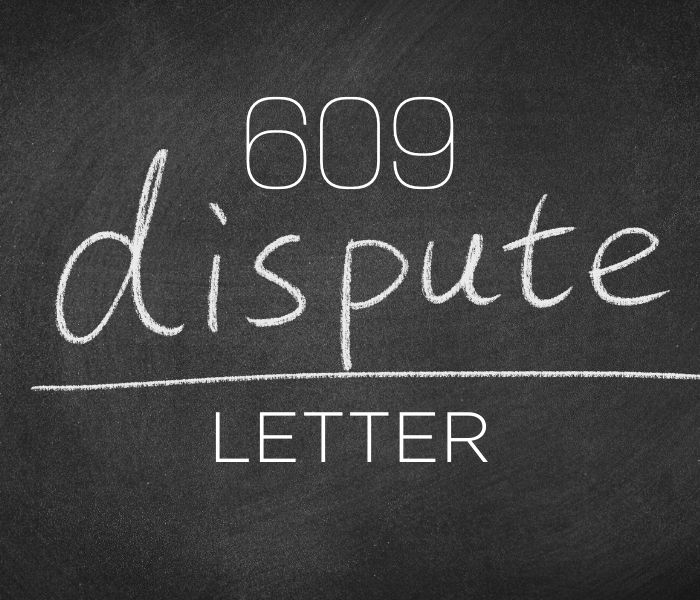Does the credit bureau have it all wrong? Everyone makes mistakes, but when it comes to your credit score and report, those are powerful consequences you shouldn’t have to suffer. That’s why consumers can dispute items on their credit report, and one way to do this is with a 609-dispute letter.
What is a 609 Dispute Letter?

Under Section 609 of the Fair Credit Reporting Act, consumers have been given the federal right to request all the details of their credit files and where that information came from. This gives you access to the same information the credit bureau uses to give you a credit score. If they’re using inaccurate information, you can dispute the debt that might be killing your score.
A 609-dispute letter starts the ball rolling on this process. You can submit a 609-dispute letter to request information from the credit bureau to check against your own records and knowledge, then request the removal of erroneous items.
Do 609 Dispute Letters Work?
For many consumers, 609 dispute letters have allowed them to challenge errors on their credit reports that are holding them back from accessing credit options. So yes, they do work. But there’s a catch — there is no single dispute letter “template” that offers surefire results.
The letter is simply the vehicle to start a conversation and investigation with the credit bureau. It does not guarantee that you will get the outcome you want. If the credit bureau can provide sufficient evidence that supports their decision, there isn’t much else you can do.
Similarly, a 609-dispute letter cannot help you avoid debt collections. If the bureau can verify the debt and it isn’t old debt, a 609 letter won’t help you remove it from your credit report.
609 Dispute Letter Example
What goes into writing a 609-dispute letter? Here’s some examples of copy you can use to write your own letter:
“Dear [name of credit bureau],
I am writing to you under the Fair Credit Reporting Act Section 609 to request information regarding an item on my credit report. I believe this item to be an error and am investigating in hopes of having the item removed.
[list specific details of the credit item, including the account name and amount]
To assist in this investigation, I’ve included a copy of my birth certificate, driver’s license, Social Security Card, proof of residency, and W2. I have also included a copy of my credit report with the item in question highlighted.
If you cannot verify this credit account with the original contract that contains my signature, please remove this information from my credit report within the next 30 days.
Sincerely,
[Your signature]
[Your printed name]
[Your personal details, including name, address, date of birth, and social security number]
You do not have to use this 609-dispute letter template, but it does help you include all the right information. I have free dispute letter templates for you to use inside of my Free Financial Resource Center, CreditMakesSense.me. Here are some other details you should include in your dispute:
● Your attorney’s contact information (if you have retained legal counsel)
● Your account number with the credit reporting bureau (should be listed on your credit report from that bureau)
● References to any documents you’ve included in your dispute letter
Make sure any identification is government-issued. Be specific about the item(s) you’re disputing. And most importantly, make sure you clearly request that disputed items be removed from your credit report if the bureau is unable to produce the evidence you seek.
For more resources on dispute letters, check out my free credit dispute letter package.
How to Dispute Errors on Your Credit Report

Can a 609-dispute letter help you get your credit score back in a healthy range? It might!
The first thing you need to do is get a copy of your full credit report. Comb through each item listed and check for discrepancies. If you notice any red flags, it’s time to write a 609-dispute letter.
Use the 609-dispute letter template or create your own. Then, make copies of all the required documentation to include with your letter. Send it via certified mail so you can track its journey and know when it’s been received. You can also request a return receipt as proof of delivery.
You do not need a lawyer or credit repair expert to write and send a 609-dispute letter. These resources can be valuable, especially if you’re not confident in handling this process yourself. But enlisting an expert is not a requirement.
One more item of note: the first time isn’t always the charm. Be prepared to send a follow-up dispute letter if you do not receive a reply from the credit bureau. Your first letter should get the process started; however, it may take anywhere from 30 to 45 days for the bureau to complete its investigation. Once the investigation is completed, the bureau should provide a written response within five business days.
Be patient and persistent — and don’t pay for someone else’s mistake!
Want to take charge of your credit score? Take my free Credit Class Today!









